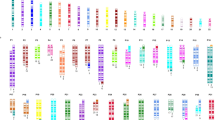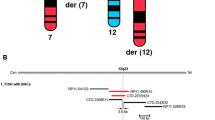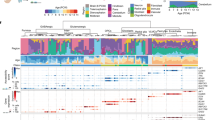Abstract
Structural chromosome abnormalities have aided in gene identification for over three decades. Delineation of the deletion sizes and rearrangements allows for phenotype/genotype correlations and ultimately assists in gene identification. In this report, we have delineated the precise rearrangements in four subjects with deletions, duplications, and/or triplications of 1p36 and compared the regions of imbalance to two cases recently published. Fluorescence in situ hybridization (FISH) analysis revealed the size, order, and orientation of the duplicated/triplicated segments in each subject. We propose a premeiotic model for the formation of these complex rearrangements in the four newly ascertained subjects, whereby a deleted chromosome 1 undergoes a combination of multiple breakage-fusion-bridge (BFB) cycles and inversions to produce a chromosome arm with a complex rearrangement of deleted, duplicated and triplicated segments. In addition, comparing the six subjects' rearrangements revealed a region of overlap that when triplicated is associated with craniosynostosis and when deleted is associated with large, late-closing anterior fontanels. Within this region are the MMP23A and -B genes. We show MMP23 gene expression at the cranial sutures and we propose that haploinsufficiency results in large, late-closing anterior fontanels and overexpression results in craniosynostosis. These data emphasize the important role of cytogenetics in investigating and uncovering the etiologies of human genetic disease, particularly cytogenetic imbalances that reveal potentially dosage-sensitive genes.
Similar content being viewed by others
Log in or create a free account to read this content
Gain free access to this article, as well as selected content from this journal and more on nature.com
or
References
Francke U : Regional localization of the human genes for malate dehydrogenase-1 and isocitrate dehydrogenase-1 on chromosome 2 by interspecific hybridization using human cells with the balanced reciprocal translocation t(1;2) (q32;q13). Cytogenet Cell Genet 1975; 14: 308–312.
Nickerson E, Greenberg F, Keating MT, McCaskill C, Shaffer LG : Deletions of the elastin gene at 7q11.23 occur in approximately 90% of patients with Williams syndrome. Am J Hum Genet 1995; 56: 1156–1165.
Ewart AK, Morris CA, Atkinson D et al: Hemizygosity at the elastin locus in a developmental disorder, Williams syndrome. Nat Genet 1993; 5: 11–16.
Breuning MH, Dauwerse HG, Fugazza G et al: Rubinstein–Taybi syndrome caused by submicroscopic deletions within 16p13.3. Am J Hum Genet 1993; 52: 249–254.
Ballabio A, Andria G : Deletions and translocations involving the distal short arm of the human X chromosome: review and hypotheses. Hum Mol Genet 1992; 1: 221–227.
Stankiewicz P, Lupski JR : Genome architecture, rearrangements and genomic disorders. Trends Genet 2002; 18: 74–82.
Wu YQ, Sutton VR, Nickerson E et al: Delineation of the common critical region in Williams syndrome and clinical correlation of growth, heart defects, ethnicity, and parental origin. Am J Med Genet 1998; 78: 82–89.
Shaffer LG, Lupski JR : Molecular mechanisms for constitutional chromosomal rearrangements in humans. Annu Rev Genet 2000; 34: 297–329.
Heilstedt HA, Ballif BC, Howard LA, Kashork CD, Shaffer LG : Population data suggest that deletions of 1p36 are a relatively common chromosome abnormality. Clin Genet 2003; 64: 310–316.
Shapira SK, McCaskill C, Northrup H et al: Chromosome 1p36 deletions: the clinical phenotype and molecular characterization of a common newly delineated syndrome. Am J Hum Genet 1997; 61: 642–650.
Slavotinek A, Shaffer LG, Shapira SK : Monosomy 1p36. J Med Genet 1999; 36: 657–663.
Heilstedt HA, Ballif BC, Howard LA et al: Physical map of 1p36, placement of breakpoints in monosomy 1p36, and clinical characterization of the syndrome. Am J Hum Genet 2003; 72: 1200–1212.
Wu YQ, Heilstedt HA, Bedell JA et al: Molecular refinement of the 1p36 deletion syndrome reveals size diversity and a preponderance of maternally derived deletions. Hum Mol Genet 1999; 8: 313–321.
Colmenares C, Heilstedt HA, Shaffer LG et al: Loss of the SKI proto-oncogene in individuals affected with 1p36 deletion syndrome is predicted by strain-dependent defects in Ski−/− mice. Nat Genet 2002; 30: 106–109.
Heilstedt HA, Burgess DL, Anderson AE et al: Loss of the potassium channel beta-subunit gene, KCNAB2, is associated with epilepsy in patients with 1p36 deletion syndrome. Epilepsia 2001; 42: 1103–1111.
Heilstedt HA, Shapira SK, Gregg AR, Shaffer LG : Molecular and clinical characterization of a patient with duplication of 1p36.3 and metopic synostosis. Clin Genet 1999; 56: 123–128.
Garcia-Heras J, Corley N, Garcia MF, Kukolich MK, Smith KG, Day DW : De novo partial duplications 1p: report of two new cases and review. Am J Med Genet 1999; 82: 261–264.
Warden CR, Pillers DA, Rice MJ et al: Interstitial duplication of the short arm of chromosome 1 in a newborn with congenital heart disease and multiple malformations. Am J Med Genet 2001; 101: 100–105.
Ballif BC, Yu W, Shaw CA, Kashork CD, Shaffer LG : Monosomy 1p36 breakpoints suggest pre-meiotic breakage-fusion-bridge cycles are involved in generating terminal deletions. Hum Mol Genet 2003; 12: 2153–2165.
Yu W, Ballif BC, Kashork CD, Heilstedt HA, Shaw CA, Shaffer LG : Development of a comparative genomic hybridization microarray and demonstration of its utility with 25 well-characterized human 1p36 deletions. Hum Mol Genet 2003; 12: 2145–2152.
Wessendorf S, Fritz B, Wrobel G et al: Automated screening for genomic imbalances using matrix-based comparative genomic hybridization. Lab Invest 2002; 82: 47–60.
Ballif BC, Kashork CD, Shaffer LG : FISHing for mechanisms of cytogenetically defined terminal deletions using chromosome-specific subtelomeric probes. Eur J Hum Genet 2000; 8: 764–770.
Shaffer LG, McCaskill C, Han JY et al: Molecular characterization of de novo secondary trisomy 13. Am J Hum Genet 1994; 55: 968–974.
O'Brien TW : Evolution of a protein-rich mitochondrial ribosome: implications for human genetic disease. Gene 2002; 286: 73–79.
Fitzgerald J, Tay Ting S, Bateman JF : WARP is a new member of the von Willebrand factor A-domain superfamily of extracellular matrix proteins. FEBS Lett 2002; 517: 61–66.
Fitzgerald J, Bateman JF : Is there an evolutionary relationship between WARP (von Willebrand factor A-domain-related protein) and the FACIT and FACIT-like collagens? FEBS Lett 2003; 552: 91–94.
Ogura T, Wilkinson AJ : AAA+ superfamily ATPases: common structure – diverse function. Genes Cells 2001; 6: 575–597.
Yoshida Y, Tanaka S, Umemori H et al: Negative regulation of BMP/Smad signaling by Tob in osteoblasts. Cell 2000; 103: 1085–1097.
Yoshida Y, von Bubnoff A, Ikematsu N et al: Tob proteins enhance inhibitory Smad–receptor interactions to repress BMP signaling. Mech Dev 2003; 120: 629–637.
Visse R, Nagase H : Matrix metalloproteinases and tissue inhibitors of metalloproteinases: structure, function, and biochemistry. Circ Res 2003; 92: 827–839.
Clancy BM, Johnson JD, Lambert A-J et al: A gene expression profile for endochondral bone formation: oligonucleotide microarrays establish novel connections between known genes and BMP-2-induced bone formation in mouse quadriceps. Bone 2003; 33: 46–63.
Lahti JM, Xiang J, Kidd VJ : The PITSLRE protein kinase family. Prog Cell Cycle Res 1995; 1: 329–338.
Lahti JM, Valentine M, Xiang J et al: Alterations in the PITSLRE protein kinase gene complex on chromosome 1p36 in childhood neuroblastoma. Nat Genet 1994; 7: 370–375.
Ishida N, Kawakita M : Molecular physiology and pathology of the nucleotide sugar transporter family (SLC35). Pflugers Arch 2003; 447: 768–775.
Lerner F, Niere M, Ludwig A, Ziegler M : Structural and functional characterization of human NAD kinase. Biochem Biophys Res Commun 2001; 288: 69–74.
Cabrera-Vera TM, Vanhauwe J, Thomas TO et al: Insights into G protein structure, function, and regulation. Endocr Rev 2003; 24: 765–781.
Downes GB, Gautam N : The G protein subunit gene families. Genomics 1999; 62: 544–552.
Mihalek RM, Banerjee PK, Korpi ER et al: Attenuated sensitivity to neuroactive steroids in gamma-aminobutyrate type A receptor delta subunit knockout mice. Proc Natl Acad Sci USA 1999; 96: 12905–12910.
Leitges M, Sanz L, Martin P et al: Targeted disruption of the zetaPKC gene results in the impairment of the NF-kappaB pathway. Mol Cell 2001; 8: 771–780.
Kaufman CD, Martinez-Rodriguez G, Hackett Jr PB : Ectopic expression of c-ski disrupts gastrulation and neural patterning in zebrafish. Mech Dev 2000; 95: 147–162.
Sato K, Sato M, Nakano A : Rer1p, a retrieval receptor for ER membrane proteins, recognizes transmembrane domains in multiple modes. Mol Biol Cell 2003; 14: 3605–3616.
Warren DS, Morrell JC, Moser HW, Valle D, Gould SJ : Identification of PEX10, the gene defective in complementation group 7 of the peroxisome-biogenesis disorders. Am J Hum Genet 1998; 63: 347–359.
Zhou B, Westaway SK, Levinson B, Johnson MA, Gitschier J, Hayflick SJ : A novel pantothenate kinase gene (PANK2) is defective in Hallervorden–Spatz syndrome. Nat Genet 2001; 28: 345–349.
Iso T, Kedes L, Hamamori Y : HES and HERP families: multiple effectors of the Notch signaling pathway. J Cell Physiol 2003; 194: 237–255.
Ross SE, Greenberg ME, Stiles CD : Basic helix–loop–helix factors in cortical development. Neuron 2003; 39: 13–25.
Zine A : Molecular mechanisms that regulate auditory hair-cell differentiation in the mammalian cochlea. Mol Neurobiol 2003; 27: 223–238.
Montgomery RI, Warner MS, Lum BJ, Spear PG : Herpes simplex virus-1 entry into cells mediated by a novel member of the TNF/NGF receptor family. Cell 1996; 87: 427–436.
Marsters SA, Ayres TM, Skubatch M, Gray CL, Rothe M, Ashkenazi A : Herpesvirus entry mediator, a member of the tumor necrosis factor receptor (TNFR) family, interacts with members of the TNFR-associated factor family and activates the transcription factors NF-kappaB and AP-1. J Biol Chem 1997; 272: 14029–14032.
Vainio S, Jalkanen M, Vaahtokari A et al: Expression of syndecan gene is induced early, is transient, and correlates with changes in mesenchymal cell proliferation during tooth organogenesis. Dev Biol 1991; 147: 322–333.
Francke U, Ochs HD, de Martinville B et al: Minor Xp21 chromosome deletion in a male associated with expression of Duchenne muscular dystrophy, chronic granulomatous disease, retinitis pigmentosa and McLeod syndrome. Am J Hum Genet 1985; 37: 250–267.
Wu YQ, Badano JL, McCaskill C, Vogel H, Potocki L, Shaffer LG : Haploinsufficiency of ALX4 as a potential cause of parietal foramina in the 11p11.2 contiguous gene-deletion syndrome. Am J Hum Genet 2000; 67: 1327–1332.
Solinas-Toldo S, Lampel S, Stilgenbauer S et al: Matrix-based comparative genomic hybridization: biochips to screen for genomic imbalances. Genes Chromosomes Cancer 1997; 20: 399–407.
Pinkel D, Segraves R, Sudar D et al: High resolution analysis of DNA copy number variation using comparative genomic hybridization to microarrays. Nat Genet 1998; 20: 207–211.
Albertson DG, Ylstra B, Segraves R et al: Quantitative mapping of amplicon structure by array CGH identifies CYP24 as a candidate oncogene. Nat Genet 2000; 25: 144–146.
Buckley PG, Mantripragada KK, Benetkiewicz M et al: A full-coverage, high-resolution human chromosome 22 genomic microarray for clinical and research applications. Hum Mol Genet 2002; 11: 3221–3229.
Veltman JA, Schoenmakers EF, Eussen BH et al: High-throughput analysis of subtelomeric chromosome rearrangements by use of array-based comparative genomic hybridization. Am J Hum Genet 2002; 70: 1269–1276.
Albertson DG : Profiling breast cancer by array CGH. Breast Cancer Res Treat 2003; 78: 289–298.
Paris PL, Albertson DG, Alers JC et al: High-resolution analysis of paraffin-embedded and formalin-fixed prostate tumors using comparative genomic hybridization to genomic microarrays. Am J Pathol 2003; 162: 763–770.
McClintock B : The behavior of successive nuclear divisions of a chromosome broken at meiosis. Proc Natl Acad Sci USA 1939; 25: 405–416.
McClintock B : The stability of broken ends of chromosomes in Zea mays. Genetics 1941; 26: 234–282.
Ballif BC, Wakui K, Gajecka M, Shaffer LG : Translocation breakpoint mapping and sequence analysis in three monosomy 1p36 subjects with der(1)t(1;1)(p36;q44) suggest mechanisms for telomere capture in stabilizing de novo terminal rearrangements. Hum Genet 2004; 114: 198–206.
Thorburn WM : Occam's razor. Mind 1915; 24: 287–288.
Astbury C, Eichler E, Christ L, Schwartz S : Delineation of deletions and complexity in ‘balanced’ chromosome rearrangements: Occam's Razor bites the dust. Am J Hum Genet 2003; 73A: 203, (abstract).
Rice D, Rice R, Thesleff I : Molecular mechanisms in calvarial bone and suture development, and their relation to craniosynostosis. Eur J Orthod 2003; 25: 139–148.
Cohen Jr MM : Malformations of the craniofacial region: evolutionary, embryonic, genetic, and clinical perspectives. Am J Med Genet 2002; 115: 245–268.
Cohen Jr MM, MacLean R (eds) Craniosynostosis: diagnosis, evaluation, and management. Oxford: Oxford University Press, 2002.
Jabs EW, Muller U, Li X et al: A mutation in the homeodomain of the human MSX2 gene in a family affected with autosomal dominant craniosynostosis. Cell 1993; 75: 443–450.
Birkedal-Hansen H, Moore WG, Bodden MK et al: Matrix metalloproteinases: a review. Crit Rev Oral Biol Med 1993; 4: 197–250.
Gururajan R, Grenet J, Lahti JM, Kidd VJ : Isolation and characterization of two novel metalloproteinase genes linked to the Cdc2L locus on human chromosome 1p36.3. Genomics 1998; 52: 101–106.
Velasco G, Pendás AM, Fueyo A, Knäupert V, Murphy G, López-Otín C : Cloning and characterization of human MMP-23, a new matrix metalloproteinase predominantly expressed in reproductive tissues and lacking conserved domains in other family members. J Biol Chem 1999; 274: 4570–4576.
Acknowledgements
We thank the subjects and their families for their participation in this research. We thank Dr Helen E Roberts, Norfolk, VA, for clinical information on subject 64. We also thank Dr J Ohnishi (Hokkaido University, Sapporo, Japan) for the Mmp23 mRNA probe. This study was supported in part by grants from the NIH National Institute of Deafness and Other Communication Disorders K08 DC00169 (HAH) and NIH National Institute for Child Health and Development P01 HD39420 (LGS).
Author information
Authors and Affiliations
Corresponding author
Additional information
Electronic database information
Ensembl: http://www.ensembl.org
NCBI genome browser: http://www.ncbi.nlm.org
UCSC genome browser: http://genome.ucsc.edu
Rights and permissions
About this article
Cite this article
Gajecka, M., Yu, W., Ballif, B. et al. Delineation of mechanisms and regions of dosage imbalance in complex rearrangements of 1p36 leads to a putative gene for regulation of cranial suture closure. Eur J Hum Genet 13, 139–149 (2005). https://doi.org/10.1038/sj.ejhg.5201302
Received:
Revised:
Accepted:
Published:
Issue date:
DOI: https://doi.org/10.1038/sj.ejhg.5201302
Keywords
This article is cited by
-
Deletion in 1p36.33-p36.32 is associated with pancytopenia: a case report
BMC Medical Genomics (2023)
-
RETRACTED ARTICLE: Clinical characterization of familial 1p36.3 microduplication
neurogenetics (2023)
-
Molecular characterization of a 1p36 chromosomal duplication and in utero interference define ENO1 as a candidate gene for polymicrogyria
European Journal of Human Genetics (2020)
-
Chromothripsis with at least 12 breaks at 1p36.33-p35.3 in a boy with multiple congenital anomalies
Molecular Genetics and Genomics (2015)
-
The first patient with a pure 1p36 microtriplication associated with severe clinical phenotypes
Molecular Cytogenetics (2014)



